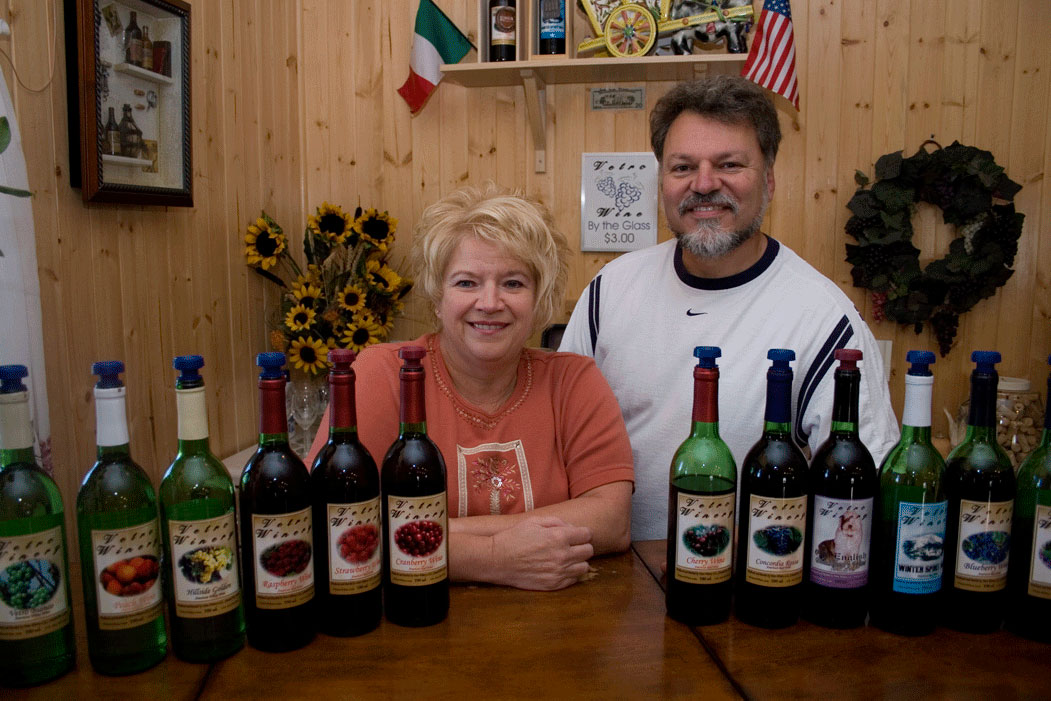 |
|
 |
| Aged to Perfection |
| Pop Art |
| Bottling Up Success |
| Edible Art |
| Bottling Up Success: The Ingenuity Behind Wisconsin Wine | ||||||||
| Abby Wucherer | ||||||||
Bill and LaVerne Vetrano’s first venture into cranberry wine left them picking stray pieces of fruit from their hair and off the walls. The hard, dry little fruits resisted efforts to crush them using a traditional grape press and de-stemmer, instead ricocheting out of the machine in all directions, like freshly popped popcorn. After some trial and error, Bill Vetrano said he realized the only way to get the cranberries to behave was to freeze them. “You got to freeze them first and then it gets a little mushier, a little easier to deal with,” he explained.
Winemaking in Wisconsin requires a certain kind of ingenuity and the drive to explore beyond traditional grape wines like those produced in states where the growing conditions are more favorable to the age-old art. In America’s dairyland, the products are sweeter, the hunt for local fruit more elusive and the process more reliant on the creativity of the winemaker. Fruit wines set Wisconsin’s wine market slightly apart from the rest of the country. The Vetranos have developed 15 different recipes, many of them fruit wines made from Wisconsin ingredients. With strawberries from Hubbleton, cherries from Fort Atkinson, cranberries from Warren and blackberries from Black River Falls, Vetrano has found a way to bottle many of Wisconsin’s most distinctive flavors. LaVerne Vetrano also observed the current trend in the California wine market that combines grapes, blending them to create new and different flavors. At Vetro Winery, the Vetranos only brew single fruit wine, with the exception of their award-winning Spirit Hill, a combination of cranberries and strawberries blended with grapes. “I think that’s a huge difference,” Bill Vetrano said. “It’s strange, and a lot of people will come in and we’ll give them a little taste of strawberry and they’ll say, ‘Wow! You can taste strawberries.’ And I’ll say, ‘Yeah, I thought that was the point.’” Despite their many other fruit wines, the Vetranos also make grape wines, often with grapes literally grown in their backyard. The tiny vineyard isn’t easy to maintain, though. When Bill Vetrano planted an acre and a half of his land with Concord and Niagara grapes four years ago, he said he didn’t realize how much time and energy he would have to spend maintaining the fragile vines. “I thought it would be like planting corn,” Bill Vetrano said. “You know, you plant it and harvest it in the fall. It’s a lot more difficult. There’s pruning and tying, spraying, all that. It’s just constant.” In addition to needing continual attention, the vines are also in danger from local predators: the deer that prowl the fields and woodlands near the Vetranos' home. Ignoring the grapes themselves, Vetrano said that they go straight for the tender young plants, “chomping them down to nothing.” “I had to tell the neighbors, quit looking for the deer with the big horns, just shoot them all,” he joked. “They’ve been leaving [the grape plants] alone now the last couple of years.” The Vetranos harvest their grapes once a year, usually during the second or third week in September. About 180 of the original 200 plants remain, and once each plant produces at full potential, LaVerne Vetrano estimated that the acre and a half will produce five tons of grapes, or 20 to 25 pounds per plant. Certain grapes simply can’t be found in the state. Vetrano orders his merlot, chardonnay and zinfandel from California. Kyle Gomon, owner and winemaker of Mason Creek Winery in Pewaukee, imports most of his grapes from California and New York. Even so, Gomon has begun to forge relationships with local wineries. He said he has teamed up with two local vineyards to make ice wine, a sweet dessert wine made from grapes frozen on the vine, and port, another sweet dessert wine with origins in Portugal. Those sweet wines come in demand. Gomon said that when he opened his winery in 2000, he carried more dry wines but has since begun to make more sweet wine. Among the most popular wines that Gomon brews are Gomon’s Gold, a semi-dry white wine, and Cranberry Wine, a sweet red with a tart finish. |
||||||||
1 | 2 | 3 print this article |
||||||||
Home | Sights | Sounds | Tastes | Experiences | Our Picks
About Us | Contact Us | Business Partners | Archives | Sitemap
Copyright 2007 Curb Magazine
